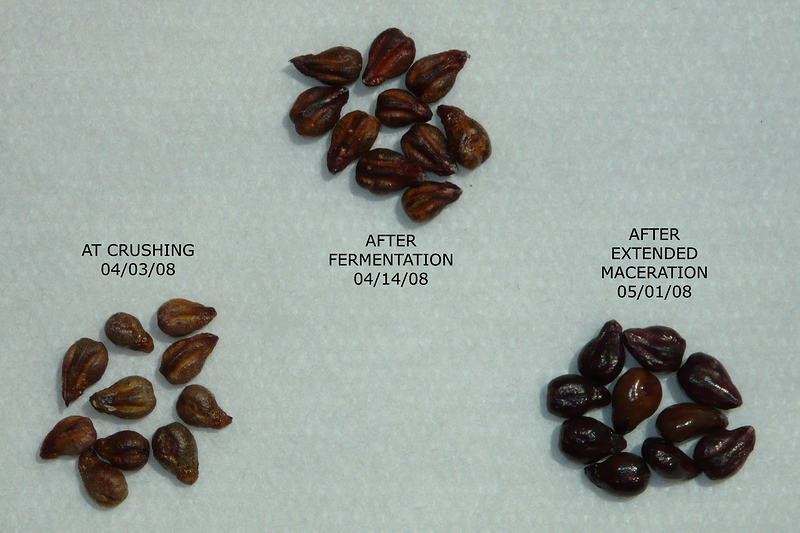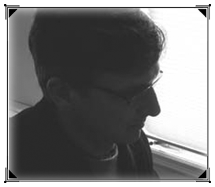Today at 12:15 the Pod was reading 1° Brix at 75° F after the punch. Despite this reading I believe the alcoholic fermentation has gone to completion, which I will confirm tomorrow with a sample for lab analysis.
At the end of the Rancho Sarco Cabernet ferment I was seeing very low Brix readings from the Pod. The higher readings I'm seeing now could be due to the sensor re-calibration, and also to the lower initial Brix of this must. Speculation, until I get the lab results.
While work on the must is slow I thought I might digress into a discussion of what is important in this kind of winemaking, versus what qualifies as minutiae, or distractions –
big things and small things.
First I need to define what "this kind of winemaking" is – what is the objective to be achieved. The WinePod system (the Pod, the WineCoach software and knowledge base, the grapes, the consumables kits and options, and the online community) is designed to enable enthusiasts to produce
high-quality dry red wines which can be bottled without filtration. Some things are more critical to realizing this goal than others.
The Big ThingsThe number one biggest thing is the grapes. The most important determinants of whether the outcome will meet expectations are: the choice of varietal, the quality of the vineyard and the fruit it produces in any vintage, and how that fruit is handled before fermentation. Provina has done a great job of sourcing superior fruit, and in handling it properly to arrive at the end user's doorstep in top condition. The user has the choice of varietal and vineyard. Beyond that the key to a good outcome is for the user to thaw the fruit quickly – with the buckets closed – and to get it into the Pod with SO
2 as quickly as possible.
NOTE: Some WinePod users are going to want to make "organic" wines without the use of SO2. While it is possible to do so, (assuming a source of organic grapes, which Provina does not currently supply) I don't recommend it for a number of reasons. Foremost is the chance for spoilage organisms to ruin the wine, which SO2 use mitigates. But even absent spoilage it is my firmly held opinion, based on long consulting experience, that wines made without SO2 are simply not as palatable as wines made with. That said, I don't want to discourage potential users from experimenting. I do think that those who won't use SO2 should examine their reasons, and ask themselves if they might have other chemical sensitivities that could impact how they use the Pod.
After the grapes, the next most important big thing
is the choice of oak. First, the choice of whether to use it at all. Second, the choice of using barrels or some substitute. And third, whether to use French, European or American oak. Each one of these choices strongly impacts how the wine will turn out, and poor choices here can result in very poor outcomes. My advice is to err on the side of caution – if a little is good then
less is better, not more.
After the choice of oak,
assuring a complete fermentation is the next most important big thing. A stuck ferment – either alcoholic or malolactic – will degrade the quality of the wine regardless of the quality of the fruit or the wisdom of the oak choice. The keys here are for the end user to clean the equipment thoroughly to minimize the chance for microbial contamination, to feed the yeast properly, and to make sure the fermentation does not get too hot.
NOTE: Again, there will be users who will choose to eschew the use of the selected yeasts, nutrients and bacteria included in the kit. This should be discouraged. While it is possible to produce a palatable wine by employing "native" yeast and bacteria in the microbially rich commercial winery setting, the uninoculated approach is far less likely to succeed outside this environment. The WinePod user has far fewer options than are available to the commercial winemaker for dealing with an incompletely fermented wine. An example is sterile filtration, common commercially but available to very few WinePod users.
The last big thing is
the choice of whether or not to add tannin and specialty yeast extract to the must before fermentation. I debated including this in the big thing category, and finally decided that it is an important choice. In my experience if one were to make, say, five Cabernets each from a different vineyard, the resulting wines would smell and taste more alike if tannins and specialty extracts were used than if they weren't. The wines made with these products are likely to be more uniformly palatable than the wines made without, however. Whether or not to use them becomes a philosophical decision.
The Small ThingsBasically, I believe that anything not directly related to the four big things above is a small thing. For example, the choice of which specific tannin and specialty yeast extract products to use is much less important than the choice of whether to use them or not.
The choice of which yeast or bacteria strain to use is of much less significance than how they are prepared and what rates are used, in order to assure complete fermentations.
What specific nutrients to use (Fermaid, Superfood, or yeast extract, yeast hulls and Cerevit) is less important than assuring that adequate nutrition is present to ensure a complete fermentation. The larger question is how much DAP to use in conjunction with one or more of these other foods.
The actual temperatures of fermentation and rates of change are not as important as simply making sure the ferment is not too hot or too cold. The same can be said for frequency and total number of punchdowns, which in my opinion are primarily done for temparature control – not too many and not too few.
What protocol is used to clean the Pod is less important than assuring that the user does clean it.
Given the capabilities of the WinePod press, the difference between light, medium and heavy pressing are likely be very small in most cases.
An exception to the big/small dichotomy might be whether or not to do
extended maceration. From my own experience I would never recommend that Pinot Noir be extended past normal fermenting to dryness. On the other hand, I believe that Bordeaux varietals produced by extended maceration are generally more palatable than those that aren't. Other red varietals fall somewhere between these extremes. Vineyard location factors in – low-yield, small berry, highly tannic fruit will produce a more palatable wine from extended maceration regardless of varietal.
Another exception might be
fining. In my opinion fining is always remedial. My objective in commercial production is never to have to fine a wine. The questions of whether or not to fine a particular wine, what to use, how much and when require the application of professional expertise and so are best avoided altogether. I see part of my role as identifying protocols and methods to use with Provina-sourced grapes that result in wines that don't require fining. But there are going to be WinePod wines that will benefit from a bit of remediation. Over-oaking and oxidation can be somewhat ameliorated with a combination of milk and egg whites. Excessive harsh tannins can be removed with egg white and/or gelatin. How to provide the professional expertise to assist the WinePod user base in making fining decisions is an open question at this time.
 ProVina delivered five WinePods to my winery. The plan is for me to do comparison fermentations to test hypotheses and validate protocols.
ProVina delivered five WinePods to my winery. The plan is for me to do comparison fermentations to test hypotheses and validate protocols. 











